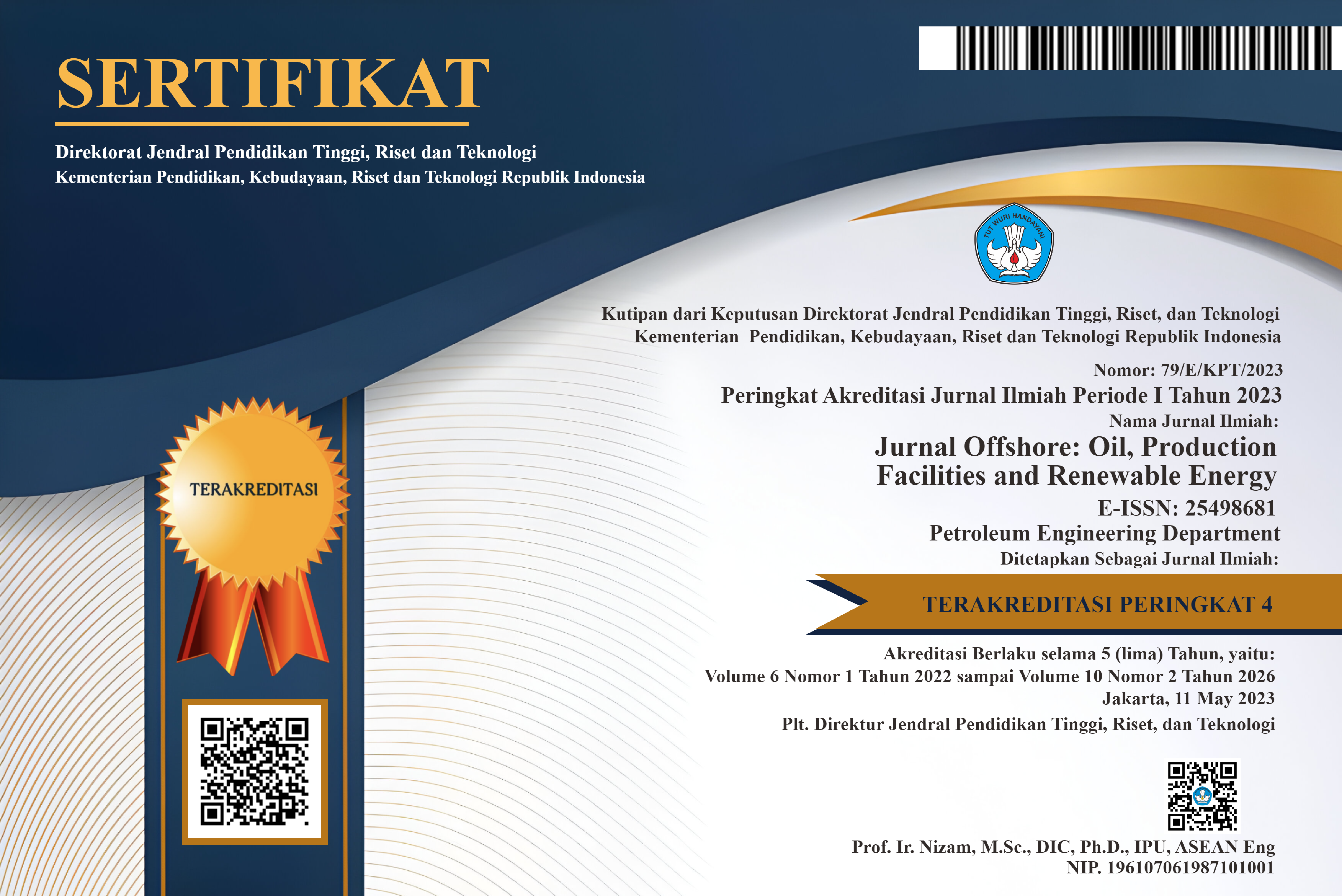Potensi Shale Hydrocarcon Formasi Brown Shale, Cekungan Sumatra Tengah Berdasarkan Data Log Mekanik
DOI:
https://doi.org/10.30588/jo.v2i1.356Keywords:
formasi brown shale, metoda passey, batuan induk migas, shale hydrocarbon, brown shale formation, passey method, oil and gas parent rockAbstract
Formasi Brown Shale merupakan batuan induk utama hidrokarbon di Cekungan Sumatra Tengah. Penelitian ini bertujuan mengevaluasi potensi formasi tersebut sebagai batuan induk hidrokarbon dan implikasinya dalam eksplorasi shale hydrocarbon berdasarkan data wireline log. Evaluasi yang dilakukan meliputi penentuan ona prospek (shale play), evaluasi kandungan material organik (TOC) untuk mengetahui tingkat kekayaan batuan induk dan evaluasi tingkat kematangannya. Tiga sumur, Sumur Gamma, Jeta dan Kilo dievaluasi dengan menggunakan Metoda Passey (1990) dan Bowman (2010) . Log Gamma Ray, Resistivitas, Sonic, Netron dan Densitas digunakan dalam studi ini.Dari hasil analisis menunjukkan Formasi Brown Shale yang tertembus oleh ketiga sumur tersebut tersusun oleh perselingan batulempung dan batulanau yang mengindikasikan mempunyai prospek sebagai batuan induk dengan tingkat kekayaan material organik miskin sampai kaya dan telah mencapai tingkat kematangan hidrokarbon. Kandungan TOC pada Sumur Gamma berkisar antara 2-8%(kaya) dan tingkat kematangan minyak dicapai pada kedalaman 6550 ft. Kandungan TOC pada Sumur Jeta berkisar antara 0-7%(miskin-kaya) dan tingkat kematangan minyak dicapai pada kedalaman 8550 ft. Kandungan TOC pada Sumur Kilo berkisar antara 0-9%(miskin-kaya) dan tingkat kematangan minyak dicapai pada kedalaman 8100 ft.Berdasarkan hasil tersebut menunjukkan Formasi Brown Shale yang tertembus oleh ketiga sumur di daerah telitian mempunyai potensi yang baik sebagai batuan induk hidrokarbon dan shale hidrokarbon.
The Brown Shale Formation is the main hydrocarbon sourcerock in the Central Sumatra Basin. This study aims to evaluate the potential of these formations as hydrocarbon bedrock and their implications in shale hydrocarbon exploration based on wireline log data. The evaluation includes determining the prospect of shale play, evaluating the total organic content (TOC) to determine the level of source rock wealth and evaluating its level of maturity. Three wells, Gamma Well, Jeta and Kilo were evaluated using the Passey (1990) and Bowman (2010) method. Gamma Ray, Resistivity, Sonic, Neutron and Density logs were used in this study. From the results of the analysis showed that the Brown Shale Formation penetrated by the three wells was composed by claystone and siltstone intervals which indicated having prospects as a source rock with poor organic to rich material levels. and has reached the level of hydrocarbon maturity. The TOC content in the Gamma Well ranges from 2-8% (rich) and the level of oil maturity is reached at a depth of 6550 ft. The TOC content in the Jeta Well ranges from 0-7% (poor-rich) and the level of oil maturity is reached at a depth of 8550 ft. The TOC content in the Kilo Well ranges from 0-9% (poor-rich) and the level of oil maturity is reached at a depth of 8100 ft. Based on these results shows the Brown Shale Formation penetrated by the three wells in the study area has good potential as a hydrocarbon host rock and hydrocarbon shale.
References
Adi Harsono, 1992, Interpretasi dan Aplikasi Log, Schlumberger Educational Services,Jakarta.
Asquith, G.B. & Gibson, C.R., 1982, Basic Well Log Analysis for Geologists, AAPG,Oklahoma.
Bowman, T, 2010, Direct Method for Determining Organic Shale Potential from Porosity and Resistivity Logs to Identify P0ossible Resource Plays, AAPG Annual Convention and Exhibition, New Orlean.
Dewan, J.T., 1983, Essentials of Modern Open-Hole Log Interpretation, Penn Well Books Co.Oklahoma.
Heidrick, T.L., & Aulia, K., 1993. A Structural and Tectonic Model of The Coastal Plains Block, Central Sumatra Basin, Indonesia. Proc., Indon. Petr. Assoc., 22st Ann. Conv., v. 1, p. 285 – 317.
Passey, Q.R. S. Creaney, J.B. Kulla, F.J. Moretti and J.D. Stroud, 1990, A Practical Model for Organic Richness from Porosity and Resistivity Logs, AAPG Bull. , Vol. 74, Hal. 1777-1794.
Downloads
Published
How to Cite
Issue
Section
License
Authors retain copyright and grant the Jurnal Offshore right of first publication with the work simultaneously licensed under a Creative Commons Attribution 4.0 International License that allows others to share (copy and redistribute the material in any medium or format) and adapt (remix, transform, and build upon the material) the work for any purpose, even commercially with an acknowledgement of the work's authorship and initial publication in Jurnal Offshore. Authors are able to enter into separate, additional contractual arrangements for the non-exclusive distribution of the journal's published version of the work (e.g., post it to an institutional repository or publish it in a book), with an acknowledgement of its initial publication in Jurnal Offshore. Authors are permitted and encouraged to post their work online (e.g., in institutional repositories or on their website) prior to and during the submission process, as it can lead to productive exchanges, as well as earlier and greater citation of published work (See The Effect of Open Access).















